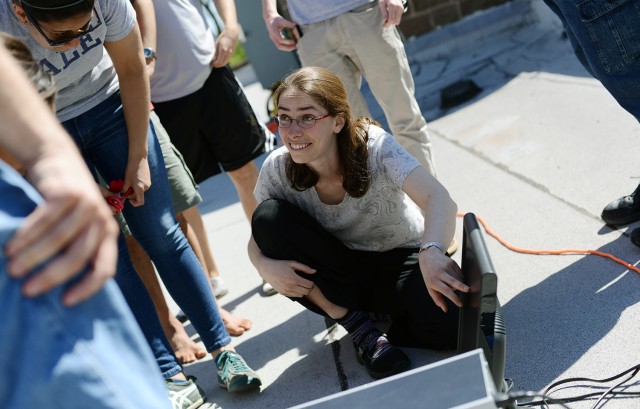Hughes Studies Formation, Evolution of Planetary Systems

(Contributed by Jim Smith)
Meredith Hughes was one of those kids drawn to science and nature. But growing up in small-town Rhode Island, she didn’t know any scientists.
“The people I knew who liked science were teachers and doctors,” recalled Hughes, a new assistant professor of astronomy at Wesleyan this year. “So I figured that’s probably what I’d be.”
Then, during her junior year of high school, a patient of her mother, a women’s health nurse practitioner, recommended a program for budding scientists called The Summer Science Program (SSP). Hughes applied, and became one of 25 students from around the world to spend the summer under the pristine skies of Ojai, California. “We spent the summer determining the orbit of 4 Vesta, the second largest object in the Asteroid Belt,” she said. “It was my first exposure to professional scientists and real research, and by the time the summer was over I had begun to think that maybe a career in science wasn’t such a crazy idea.”
Little more than a year later, she was enrolled at Yale. Despite the inroads into astrophysics she had made at SSP, she embraced the philosophy of a liberal arts education and spent her freshman year avoiding astronomy and instead exploring fields as diverse as cognitive science and music theory. During the summer she had an opportunity to stay in New Haven and do astronomical research with Professor Meg Urry, director of the Yale Center for Astronomy and Astrophysics. Hughes found it exhilarating to apply the physics she had learned in the classroom to investigating the properties of the supermassive black holes at the centers of distant galaxies.
“After that summer, I was hooked,” she said. She went on to complete A.M. and Ph.D. degrees in astronomy at Harvard in 2007 and 2010, earning the department’s Fireman Fellowship for an outstanding Ph.D. thesis in the field of experimental astrophysics.
After Harvard, she accepted a postdoctoral fellowship with the Miller Institute at the University of California-Berkeley. Former Miller Fellows have included Nobel laureates and Fields medalists, but Hughes says she was most excited to follow in the footsteps of former Miller Fellow Carl Sagan. “His career was exemplary in combining a deep understanding of research with an incredible gift at communicating his knowledge and passion to non-scientists, which is a combination I strive to emulate,” Hughes said. She was at Berkeley when she learned about the opening at Wesleyan that offered what she said was “exactly the balance of teaching and research I was looking for.”
Hughes’ research focuses on understanding the formation and evolution of planetary systems. Beginning with a huge disk of gas and dust surrounding a young star – the “junk” left over from the star’s formation – and ending with a planetary system that may or may not resemble our own, planet formation is a messy process. “Planets themselves are very hard to see,” Hughes explained, “although we’ve made a lot of progress in recent years. I sneak in the back door by studying the material the planets are born from, and how planets interact with that material as the system evolves.”
The main technique Hughes uses to observe these circumstellar disks involves collecting radio waves. Invisible to the human eye, radio light allows astronomers to peer into dense dust clouds and trace the motions of small molecules.
“It’s a very exciting time to be a radio astronomer,” Hughes noted. Construction is just finishing on the Atacama Large Millimeter Array (ALMA) in Chile, which will provide views of the radio sky as crisp as those of the Hubble Space Telescope at ten times the sensitivity of any existing radio telescope. Hughes has been awarded time for two of her own projects at the ALMA observatory this year, despite fierce competition from around the globe. “I feel very lucky to be among the first to use this incredible new facility,” Hughes said. “We can’t yet imagine all the wonders that ALMA will show us.”
The first course Hughes taught at Wesleyan, this spring, was an upper-level Radio Astronomy course for juniors, seniors and graduate students. In addition to learning the fundamentals of radio astronomy, the students built a small radio telescope (SRT) based upon a design produced at MIT’s Haystack Observatory. Mounted on the roof of the Wesleyan Observatory, the SRT will be a valuable asset for future generations of Wesleyan astronomy students. Hughes also looks forward to teaching introductory-level courses in astronomy at Wesleyan. “One of the things I love most about astronomy is that it fuels my imagination, and it’s thrilling to introduce other people to these strange and wonderful concepts.”
Aside from her teaching and research interests, it’s not surprising that Hughes is actively interested in gender-related issues in science. “We’ve come a long way,” she reported, “but women still make up only a small fraction of the professoriate, and I’d like to understand why.” As one of 11 members of the American Astronomical Society’s Committee on the Status of Women in Astronomy, she is tracking progress towards gender equity by conducting the latest in a series of demographic surveys of major astronomy institutions. She also serves as a member of the admissions and outreach committees for The Summer Science Program, helping to recruit and select new batches of young scientists for the experience that first set her sites on the sky.

